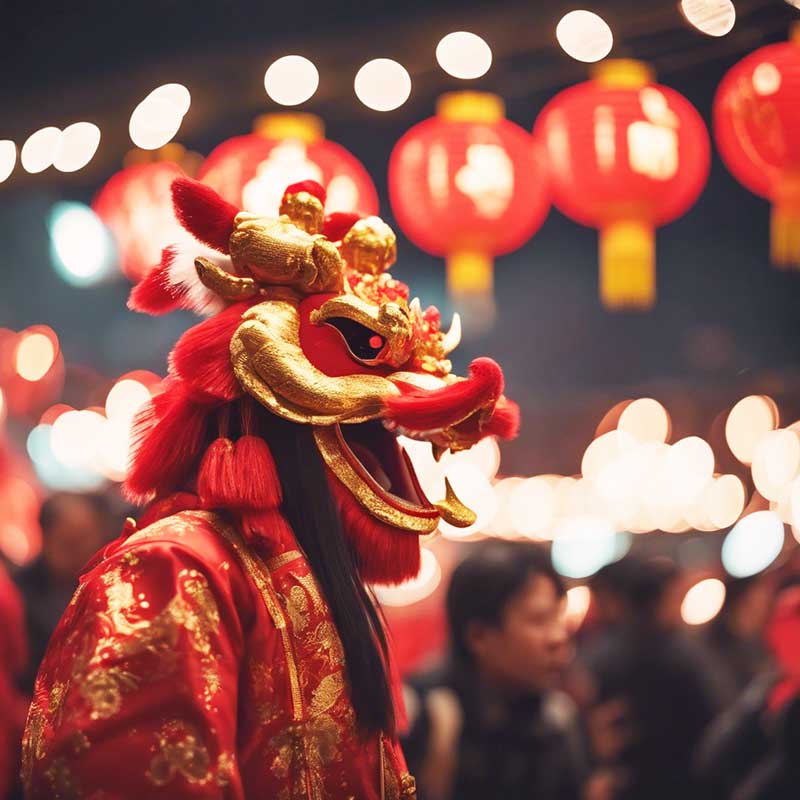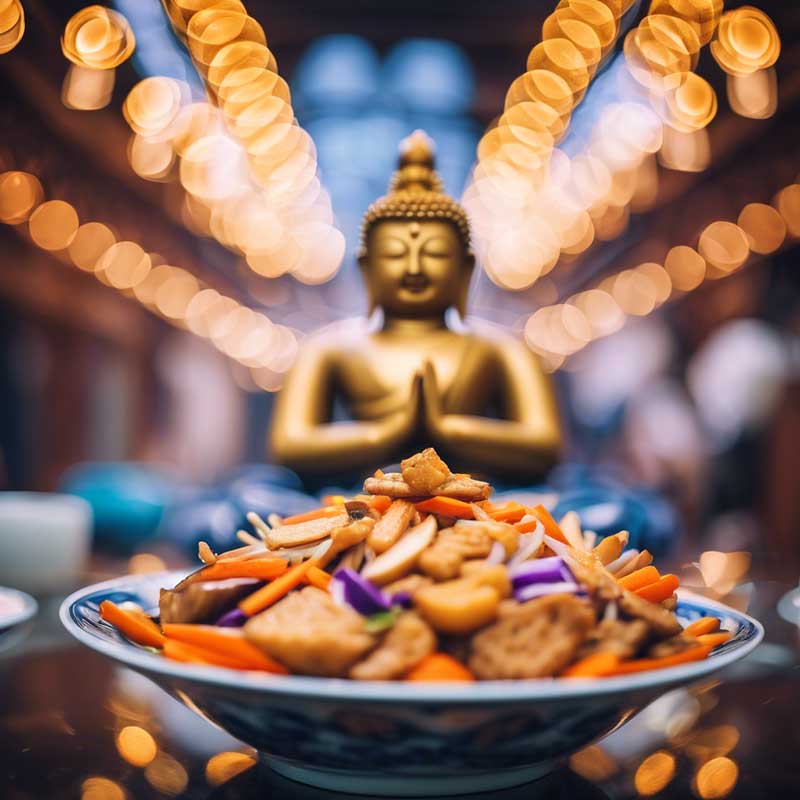Celebratory Buddha’s Delight : super tasty Chinese crispy vegetables and tofu stir-fry
Recipe Story
Buddha’s Delight known as “luóhàn zhāi” 罗汉斋 in Chinese, has its origins in Buddhist monastic cuisine. The dish is often prepared without pungent vegetables and strong spices to maintain a simple and pure taste in line with Buddhist dietary principles.
In many Chinese homes, it’s a tradition to serve Buddha’s Delight on the first day of the Lunar New Year and other Buddhist festivals. This tradition originates from an ancient Buddhist practice suggesting the benefits of consuming a vegetarian diet during the initial five days of the new year for self-purification.
The dish has unique ingredients like fat choy (a type of black hair-like algae) and arrowhead (a crunchy root vegetable), which are a bit rare and usually only enjoyed during New Year.
The variety of ingredients in the dish symbolizes abundance and prosperity for the coming year. It reflects the Buddhist philosophy of compassion towards all living beings, as it excludes ingredients derived from animals. The name “Buddha’s Delight” suggests a dish that is not only flavourful but also spiritually fulfilling.
Buddha’s Delight traditionally consists of lots of different vegetables, sometimes 18 or even up to 35, many with symbolic significance. Many believe that the red colour of carrots brings good fortune, associating carrot coins (round slices of carrots) with the symbolism of wealth. Ginkgo biloba nuts resemble silver ingots, symbolizing good fortune. Fat choy (black moss) phonetically echoes “be prosperous,” while water chestnuts and snow peas represent unity. Bamboo shoots and mung-bean threads are symbols of long life, and Nelumbo nucifera tuber (fun kok) represents a good life. People believe that soybean curd sticks bring blessings and happiness to a home, while peanuts symbolize an addition or birth in the family.
A true Zen delicacy for vegetarians 🙂


Ingredients & Substitutes
This is a simplified version with 10 ingredients, including some traditional ingredients. It largely depends on whether you have access to a Chinese shop in your area to purchase as many traditional ingredients as possible. I’ve included one ingredient not traditionally on the list, and that is peppers. I love them, and they are used in most other Chinese dishes. However, feel free to exclude them if you prefer a more traditional approach. The key is to have a nice variety of vegetables cooked in a simple Buddha’s Delight sauce, creating a healthy and enjoyable dish.
The original version includes additional ingredients such as chestnuts, peanuts, lotus seeds, ginkgo nuts, lily bulbs, and fat choy. So, if you can find any of these ingredients, feel free to add them!
10 common vegetables may include: Napa cabbage, Bok choy, Carrots, Mushrooms (shiitake, wood ear, or others), Bamboo shoots, Water chestnuts, Snow peas, Tofu or bean curd, Seaweed, Lily buds.
Of course, you can adapt it as you like, based on the vegetables you currently have in the fridge. In any case, I recommend preparing it with as many vegetables as possible and include as many traditional ingredients as possible!
Essential Vegetables: carrots, woodear or/and oyster mushrooms, nappa cabbage, snow peas, bamboo shots, ginger root.
These ingredients are crucial, and I advise against omitting any of them. If you can’t find snow peas, opt for runner beans, ensuring they’re not stringy. Include a variety of mushrooms, particularly oriental ones; shiitake mushrooms make a good substitute. Substitute napa cabbage with pak choi or young white cabbage. Even if you can’t find traditional Chinese varieties, incorporate as many vegetables as possible for a rich and satisfying outcome.
Other: noodles, tofu or beancurd. I chose wheat noodles, but in the traditional preparation of Buddha’s Delight, glass noodles are the usual choice. Nevertheless, feel free to choose the type of noodles you prefer. Just make sure to prepare them according to the package instructions BEFORE adding them into the dish.
Sauce ingredients: sugar, oyster sauce, soy sauce, peanut or sesame oil. I suggest preparing this dish with either sesame oil or peanut oil instead of plain sunflower or other vegetable oil. Sesame or peanut oil gives a distinctive oriental taste to the dish.
Cooking Tips
- Preparing Buddha’s delight is quite simple. Chop all the vegetables, soak dry ingredients like mushrooms, and pre-cook the noodles according to the package instructions in advance.
- Begin by frying the tofu first, set it aside, and then proceed to add the vegetables in the wok.
- Before adding vegetables to the wok, ensure the oil is very hot. The key is to stir-fry the vegetables quickly, maintaining a slightly crunchy texture.
- In the wok, cook the ingredients based on their required cooking times, with the hardest vegetables taking the longest time. Start by adding the toughest vegetables first such as carrots.
Presentation & Serving
Buddha’s Delight is often presented in a large communal dish or individual plates, emphasizing the colourful array of vegetables and the overall balance of flavours. The dish is sometimes garnished with fresh herbs or additional toppings for added texture and visual appeal. It might be served alongside rice or other staple grains. The presentation can vary, but the emphasis is typically on showcasing the diverse and harmonious combination of vegetarian ingredients.
Recipe Card

Simple Buddah’s Delight: Chinese Vegetables stir-fry
Ingredients
- 2 carrots - medium size
- 1 cup earwood mushrooms
- 1/2 cup green beans - snow peas
- 1/2 nappa cabbage
- 1 cup dry or fresh mixed mushrooms
- 1 piece ginger - 1" x 1" size
- 2 spring onions
- 1 onion - optional
- 1 bell pepper
- 1/2 cup bean sprouts
- 1/3 cup bamboo
- 1 tofu
- 2 portions glass noodles
- peanut or sesame oil
For the Sauce
- 200 ml dry mushroom liquid
- 2 tbsp Shaoxing wine - rice wine
- 3 tbsp soy sauce
- 1 tbsp oyster sauce
- 2 tsp sugar
- 1 tablespoon cornflour - optional
- 2-3 tablespoons peanut or sesame oil
Instructions
- First, prepare the vegetables, finely slice and chop.
![]()
- Soak the dried mushrooms in a cup of hot water or a small bowl. Save the liquid for the sauce.
- Cook the noodles according to the instructions. Drain them, set aside.
- Add oil to the wok, heat it on high, and then add tofu cut into cubes. Fry quickly, ensuring all sides are seared. Remove and set aside on a plate.
- Heat the wok again, add little bit more oil. Then add the vegetables in order of hardness, starting with the firmer ones. First add carrots. Stir-fry continuously for 2 minutes. Add 100ml of water.Now add woodear mushrooms, green beans, runner beans or snowpeas and stir-fry for additional 2 minutes.Next add onion, peppers, mushrooms and cabbage. Stir -fry for another 2-3 minutes.Lastly – add spring onion, sprout and bamboo and stir-fry for 1-2 minutes.
- Add prepared noodles and all the ingredients for the sauce.
- Stir-fry the vegetables and noodles for 2 minutes after adding the sauce. If you desire a saucy-stew consistency, add some cornflour towards the end. Mix it with 200ml of water and pour it over the vegetables. Cook for 1-2 minutes.In the last minute add tofu and careful mix it altogether.The overall stir-frying time for the vegetables should not exceed 10-12 minutes; the vegetables should remain crisp.
![]()


